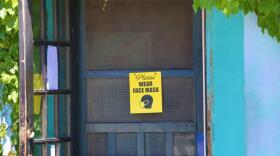This story was originally produced by the New Hampshire Bulletin, an independent local newsroom that allows NHPR and other outlets to republish its reporting.
State leaders have followed best practices in deciding how to use New Hampshire’s $995 million in American Rescue Plan money, according to a Pew Charitable Trusts analysis released Monday.
As of July 2022, the state had allotted the majority of the money, 72.5%, to one-time expenses and just over 19% to direct pandemic response, such as distributing vaccines and bolstering staffing in long-term care facilities.
Just 8.1% of the money had gone for operating expenses, which tend to require ongoing state funding. That balance, with a small portion used for recurring expenses, is important, the analysis said.
“Following this principle can help ensure fiscal stability and balanced budgets over the long term,” Pew researchers wrote. “On the other hand, spending that needs to be repeated going forward can lead to fiscal cliffs – essentially the threat of reduced funding for ongoing programs in essential state services – when the one-time money is exhausted and alternative sources are not in place.”
Pew researchers studied pandemic aid spending in five states: New Hampshire, Florida, Idaho, Illinois, and Tennessee, and American Samoa. Rebecca Thiess, manager of Pew’s fiscal federalism initiative, said researchers chose states on two grounds: They needed to be geographically diverse, and their federal pandemic spending reports had to be detailed enough to analyze.
The timing of Monday’s report was intentional: States have one more year to decide how to spend their state and local fiscal recovery funds and until 2026 to spend it.
Thiess said in a briefing with reporters Monday that the financial assistance that followed the Great Recession in 2007 led to budget shortfalls after the money was gone. The federal government has sent states even more funding to address the pandemic – with considerable flexibility on how to use it and no consensus on how to best spend it.
Pew’s report is intended to define those best practices, Thiess said.
New Hampshire allotted less to one-time expenses than most of the other jurisdictions, save for Illinois, which allotted just 4.6% to those costs, according to the report. Florida was the highest at nearly 88%.
As of July 2022, New Hampshire had allotted funding to multiple one-time expenses, including the purchase of high-quality weatherproof, portable, wireless internet connectivity devices and school physical security assessments, the report said. Other one-time expenses included the $15 million purchase of Hampstead Hospital and significant investments in expanding housing in the state.
New Hampshire invested a larger percentage of its money in responding to the pandemic than most of the six locations, save for Illinois, which allotted nearly 64% of its spending to that effort.
New Hampshire, for example, allocated $12 million of its pandemic funding toward the purchase and distribution of COVID tests for residents, Thiess said. Other examples included setting up public testing sites; providing additional staffing to elder care facilities; and giving economic support to small businesses that otherwise would have closed as a result of the pandemic.
New Hampshire was similar to other states in deciding to spend a small portion of its money on ongoing programs addressing workforce training and recruitment and support for social services.
Thiess said states should consider a number of protective measures when allocating pandemic aid to recurring expenses.
Those include: identifying ongoing alternatives for new spending; prioritizing existing programs over starting brand new ones; identifying and communicating when operational spending is actually going to be temporary; and investing in program evaluation to learn which new ideas are most effective in practice and then also minimizing the hiring of new permanent staff.
“For the most part, (the six jurisdictions) are in really solid shape,” Thiess said. “We found that based on our definitions (of expenses) … these places really did prioritize spending on pandemic response and one-time investments. Those are the types of spending that we associate with the lowest risk of future fiscal imbalance.”
Pointing to strong revenues and a robust economic recovery, New Hampshire lawmakers passed a $15.2 billion biennium budget that reduces business taxes and phases out the interest and dividends tax next year. There was less recognition during budget debates of the impact pandemic assistance had on state revenues and state spending.
Thiess has a cautionary message for lawmakers going forward.
“It’s really up to the state to take a holistic look at when this funding is going to not exist anymore and what their funding is then going to look like without this pandemic aid support,” she said. “I don’t know specifics about how those tax changes may impact the future fiscal health of the state, but I would just encourage policymakers to really take into account the one-time nature of this boom and make decisions based on that.”
New Hampshire Bulletin is part of States Newsroom, a network of news bureaus supported by grants and a coalition of donors as a 501c(3) public charity. New Hampshire Bulletin maintains editorial independence. Contact Editor Dana Wormald for questions: info@newhampshirebulletin.com. Follow New Hampshire Bulletin on Facebook and Twitter.







